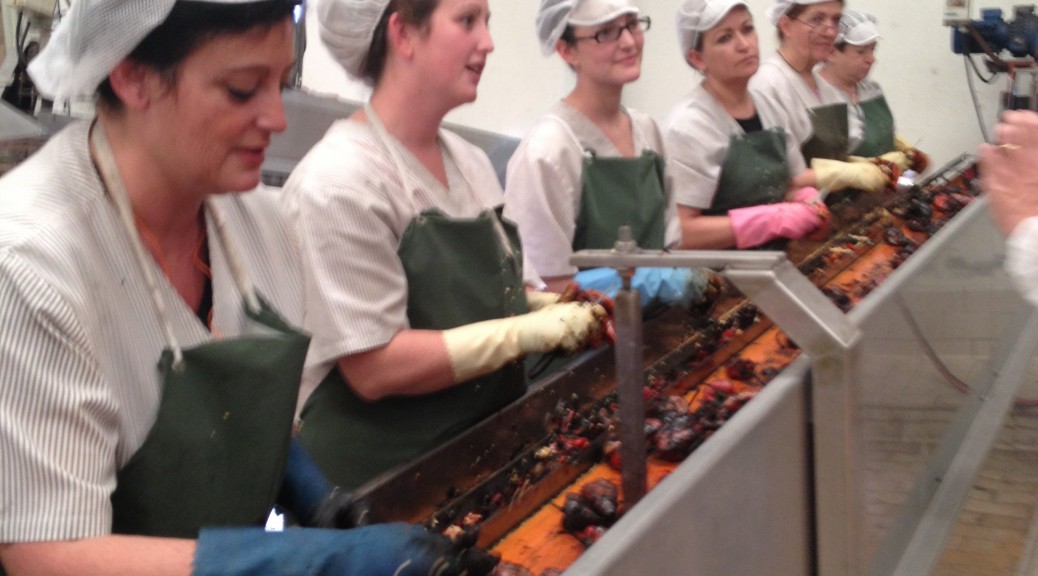In the last two decades, piquillo peppers have taken the culinary world by storm. From nowhere they became the darling ingredient of chefs across the world, including Michelin-starred gastronomic titans Alain Ducasse and Ferran Adria. What’s different about piquillos from nearly every other vegetable making it big time (I’m talking to you, kale) is that none of the piquillo peppers are fresh. They’re all canned.
Piquillos are native to Spanish Basque country.
They’ve been there for hundreds of years. Columbus brought the first chile peppers to Spain, and unlike other new world crops like potatoes and tomatoes that took centuries to really catch on, peppers took off right away. Over time, each region developed their own particular varieties. Piquillos were originally grown only around the Navarre town of Lodosa. They are small and tapered, about a couple inches wide at the stem, three to four inches long, ruby red, with an incredible complex, just barely spicy flavor.
In the 1930s, as civil war raged in Spain, families in Lodosa started jarring their fresh produce, including piquillos, to have enough food to support the troops and put up in their own pantries. The Basque are nothing if not industrious, and after the war ended the canning continued. For a few years they remained a local pantry staple, unknown anywhere else in Spain, let alone in fancy restaurants. In the 1960s, Lodosa became a hip summer vacation getaway. Tourists tried the piquillos, fell in love with them, and brought home jars as souvenirs. The peppers started to get famous.
With great fame comes great imitators.
Like so many products, as piquillos became popular, so too did the idea that you could probably make a profit by making them slightly less delicious—but considerably less expensive. Traditionally, the peppers were roasted until black and blistered over a beechwood fire. The wood fire roasting gives the peppers a deep, smoky flavor, but it also allows them to be peeled relatively easily. Raw piquillos have a thick, tough peel—too tough to chew. Once roasted, the peels are removed by hand. It’s actually pretty incredible to watch: equipped with just a pair of gloves and a paring knife, workers strip off the peels lightning fast. (You can see for yourself in this video from our source for piquillos. The peeling starts around 1:42.) That might sound (and look) easy, but though the peel is tough the flesh is delicate, so keeping the peppers intact while removing the skin takes a fair amount of skill and finesse. The final step is to put the peppers in the jar by hand with a smidge of citric acid. That’s it. There’s no water, no vinegar, no oil, not even any salt. Just the peppers and their juices.
Today, most piquillo peppers on the market aren’t made this way. For starters, many weren’t even grown in Spain. (Even most of the piquillo peppers sold in Spain weren’t grown there!) The biggest crime is in the roasting: most is done over gas fires these days, which lacks the aromatic wood smoke of the beechwood fires. It’s like the difference in flavor between grilling over gas and charcoal. If the producer doesn’t say that the peppers were roasted over wood, they probably weren’t. After roasting, most producers peel the peppers with jets of water, which removes both the skin and a fair bit of the flavor. You can tell if they were peeled by hand because you’ll see little black flecks left on the outside of the peppers—the water cleans these all off. Finally, the bogus peppers are often packed with other ingredients, like water, sugar, salt, or additional preservatives.
It’s worth hunting out real deal traditional piquillos.
Made the traditional way, piquillos have incredible flavor. The aroma is sweet and fresh, like a pepper that was just picked, warm from the sun. The flavor is a balance of bright, rich fruit with the darker, smoky notes from the wood fire. They have a velvety texture with just a teensy prickle of heat across the tongue. Eating them is a real treat.
The most popular way to eat them in Spain is to stuff them: with tuna, or chorizo, or anchovies, or fresh cheese, or whatever you have on hand. Stuffed piquillos make for tremendous appetizers or hors d’oeuvres, offering up huge flavor for very little time and effort to assemble them. You can chop them up and throw them into soups or paella or an omelet. Spread them out to include in a sandwich, maybe with some manchego and arugula on farm bread. Better yet, fry up that sandwich for a killer piquillo grilled cheese. The peppers are packed in tight in the jar, but you only need a few to add incredible flavor to any dish. Once it’s open, top off the jar with a bit of good olive oil and it’ll keep for months in the fridge.

